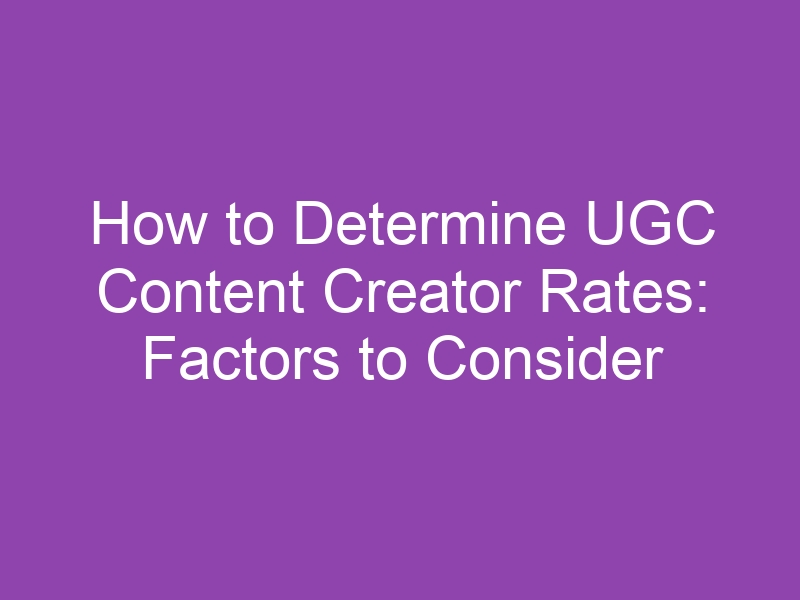Content Outline
- Introduction
- A. Definition of UGC Content
- B. Importance of UGC Content
- Factors to Consider When Charging for UGC Content
- A. Type of UGC Content
- B. Time and Effort Required
- C. Level of Expertise
- Methods for Charging for UGC Content
- A. Flat Fee
- B. Hourly Rate
- C. Revenue Share
- Conclusion
Introduction
When it comes to creating User Generated Content , one of the most common questions that comes up is how much to charge for it. There are a variety of factors that go into determining the appropriate compensation for UGC, and it’s important to consider them all to ensure a fair and reasonable payment for both the creator and the company.
Factors to Consider
- Type of Content: The type of content being created is a major factor in determining how much to pay for UGC. For example, a simple social media post may not be as valuable as a detailed product review or a high-quality video.
- Expertise: The level of expertise required to create the content is also important. If the UGC requires a high level of skill or knowledge, the compensation should reflect that.
- Reach: The reach of the UGC is another important factor. If the content will be seen by a large audience, the creator may be entitled to a higher payment.
- Deadline: The timeline for creating the UGC can also affect the compensation. If the deadline is tight, the creator may require additional compensation for working under pressure.
It’s important to strike a balance between fair compensation for the creator and the company’s budget. Offering too little payment could result in low-quality content, while offering too much could be financially unsustainable for the company.
Now that we’ve discussed the key factors to consider when determining how much to pay for UGC, let’s dive deeper into each factor to get a better understanding of how to fairly compensate creators.
Introduction – A. Definition of UGC Content
User Generated Content refers to any content that is created by users of a website or platform, typically in the form of text, images, videos, or reviews. This content is often created and shared on social media platforms, online forums, and blogs. In recent years, UGC has become an increasingly important part of digital marketing strategies, as it can help to build brand awareness and engagement.
Why UGC is Important
User Generated Content is important for several reasons. First, it can help to increase engagement and build trust with customers. According to a study by Business Wire, 90% of consumers say that authenticity is important when deciding which brands to support. UGC can help to provide this authenticity by showcasing real customers and their experiences with a product or service.
Second, User Generated Content can help to improve search engine rankings. According to a study by Search Engine Journal, websites that feature UGC have an average of 29% higher search rankings than those that do not. This is because search engines view User Generated Content as fresh and relevant content, which can improve a website’s overall quality score.
Factors to Consider When Pricing UGC Content
When it comes to pricing UGC content, there are several factors to consider. These include:
- The quality of the content
- The volume of the content
- The social media reach of the content creator
- The platform on which the content will be shared
- The exclusivity of the content
It’s important to keep in mind that User Generated Content content is often less expensive than content created by professional writers or photographers. However, it’s still important to ensure that the content meets your brand’s standards and aligns with your marketing goals.
In conclusion, UGC content can be a valuable asset for any digital marketing strategy. By understanding the factors that go into pricing UGC content, you can ensure that you’re getting the most value for your investment.
Introduction – B. Importance of UGC Content
User Generated Content is becoming increasingly important in today’s digital age. User Generated Content is any content that is created by users of a product or service, such as reviews, comments, photos, videos, and social media posts. This type of content is highly valuable because it is authentic and trustworthy, and it can help businesses build a loyal customer base.
According to a study by Business2Community, 86% of millennials say that user-generated content is a good indicator of the quality of a brand, and 68% of consumers trust reviews more when they see both good and bad scores. In addition, User Generated Content can help businesses improve their search engine rankings, since search engines value fresh and relevant content.
However, determining how much to charge for UGC content can be a challenge. Factors such as the type of content, the platform it’s published on, and the size of the business all play a role in the pricing strategy.
When considering how much to charge for UGC content, it’s important to keep in mind the overall goal of the content. Is it to increase brand awareness, drive sales, or engage with customers? This should be the starting point for any pricing strategy.
- Some factors to consider when determining pricing for UGC content include:
- The type of content (reviews, photos, videos, etc.)
- The platform the content will be published on (social media, company website, etc.)
- The size and reach of the business
- The level of engagement expected from the content
Ultimately, the value of UGC content cannot be overstated, and businesses should carefully consider how much to charge for this type of content in order to maximize its potential benefits.
Factors to Consider When Charging for UGC Content
Charging for user-generated content is a complex issue with several factors to consider. Here are some of the key factors:
- Quality of the Content: The quality of the content is a significant factor to consider when deciding how much to charge for UGC. High-quality content that provides value to your audience is likely to be worth more than lower-quality content.
- Type of Content: The type of content is also a crucial factor. Some types of UGC, such as product reviews and testimonials, may be more valuable than others.
- Engagement: The level of engagement with the content is another important consideration. Content that generates a lot of engagement, such as likes, comments, and shares, may be worth more than content with low engagement.
- Expertise: If the UGC comes from an expert in a particular field, it may be worth more than content from a general user.
- Production Costs: The costs associated with producing and managing the UGC should also be considered when setting a price. If the costs are high, the price may need to be higher to cover those costs.
Ultimately, the decision on how much to charge for UGC content should be based on a careful analysis of these factors and the tradeoffs involved. It’s also important to keep in mind that there is no one-size-fits-all answer to this question, as the value of User Generated Content can vary widely depending on the context.

For more information on how much to charge for UGC content, check out this article by Jeff Bullas, which provides some useful insights and statistics on the topic.
Factors to Consider When Charging for UGC Content – A. Type of UGC Content
When it comes to determining how much to charge for user-generated content , it’s important to consider a variety of factors. One of the most important factors to consider is the type of UGC content being created.
Types of UGC Content:
- Text-based content: This includes blog posts, reviews, comments, and social media posts. Text-based content can be easier to create and may not require as much compensation as other types of content.
- Photo and video content: This includes images, videos, and live streams. Photo and video content can require more effort and equipment to create, and may require higher compensation.
- Product or service reviews: Reviews can be text-based or visual, and can be highly valuable for businesses. Compensation for reviews may vary depending on the platform and the level of detail required.
When determining how much to charge for UGC content, it’s important to consider the effort required to create the content, as well as the value it provides to the business. Additionally, businesses should consider the platform where the content will be published and the target audience.
According to a survey by Business.com, 86% of consumers said authenticity is important when deciding what brands they like and support. User Generated Content can help businesses establish authenticity and build trust with their audience, making it a valuable investment.
Overall, determining how much to charge for UGC content can be a complex process. By considering the type of content being created and its value to the business, businesses can make informed decisions that benefit both them and their contributors.
Factors to Consider When Charging for UGC Content – B. Time and Effort Required
When it comes to charging for user-generated content , time and effort required are important factors to consider. User Generated Content can come in many forms, from blog posts and social media updates to photos and videos, and each type requires a different amount of time and effort to produce.
Time Required
- Research: The amount of research required for UGC can vary greatly depending on the topic. For example, writing a blog post about a widely discussed topic may require less research than a niche topic that requires more in-depth research.
- Writing: The time required to write a UGC piece depends on the length and complexity of the content. A short social media post may only take a few minutes to write, while a longer blog post may take several hours.
- Editing: Editing is an important part of the content creation process, and it can take a significant amount of time. Depending on the quality of the initial draft, editing may take anywhere from a few minutes to several hours.
Overall, the time required to produce UGC can vary widely depending on the type of content and the topic.
Effort Required
- Creativity: Some types of UGC, such as photos and videos, require a significant amount of creativity to produce. This may involve coming up with an interesting concept, finding the right location, and spending time on post-production.
- Expertise: UGC that requires specialized knowledge or skills, such as a how-to guide or a technical review, may require a higher level of expertise and effort to produce.
- Engagement: UGC that is designed to engage with an audience, such as a social media post or a live video, may require more effort to create and manage. This may involve responding to comments and engaging with followers in real-time.
It’s important to consider the level of effort required for each piece of User Generated Content, as this can have a significant impact on the overall cost.
When determining how much to charge for UGC content, it’s important to take into account both the time and effort required to produce the content. By doing so, you can ensure that you are fairly compensating yourself or your team for the work involved.
Sources: Sprout Social, Hubspot
Factors to Consider When Charging for UGC Content – C. Level of Expertise
When it comes to charging for user-generated content , there are several factors that need to be considered. One of the most important factors is the level of expertise required to create the content.
What is Level of Expertise?
Level of expertise refers to the skill and knowledge required to create a particular piece of content. For example, creating a simple blog post may not require a high level of expertise, while creating a technical white paper may require a significant amount of expertise and domain knowledge.
Why is Level of Expertise Important?
The level of expertise required to create User Generated Content is important because it directly affects the cost and time required to create the content. The more expertise required, the more time and effort that will need to be invested, and the higher the price that can be charged for the content.
Factors that Affect Level of Expertise
Several factors can affect the level of expertise required to create User Generated Content :
- The topic or subject matter
- The intended audience
- The format of the content (e.g. blog post, white paper, video tutorial)
- The level of research required
For example, creating a blog post on a general topic may not require a high level of expertise, while creating a technical white paper for a specialized audience may require a significant amount of research and domain knowledge.
How Much to Charge for UGC Content?
When determining how much to charge for UGC content, it’s important to consider the level of expertise required. Generally speaking, the higher the level of expertise required, the more you can charge for the content.
According to a study by the Content Marketing Institute, the average cost for a blog post is $200 to $500, while the average cost for a white paper is $5,000 to $7,000.
However, it’s important to keep in mind that there may be tradeoffs involved. For example, charging a higher price for UGC content may result in fewer clients or lower overall revenue. On the other hand, charging a lower price may result in more clients, but may not be sustainable in the long term.
Ultimately, the key is to find a balance between the level of expertise required and the price that can be charged for the content.
Sources:
Methods for Charging for UGC Content
User Generated Content has become increasingly popular in recent years. With the rise of social media, platforms like Facebook, Twitter, and Instagram have become a hub for UGC. As a result, many businesses are now looking for ways to monetize UGC. In this section, we will discuss some methods for charging for UGC content.
Pay-per-Click (PPC)
- PPC is a method of charging advertisers based on the number of clicks their ads receive.
- Some businesses charge for UGC content on a PPC basis.
- This method allows businesses to charge advertisers based on the number of clicks their UGC content receives.
- However, the downside of this method is that it may not be as effective for UGC content as it is for traditional ads.
Pay-per-Impression (PPI)
- PPI is a method of charging advertisers based on the number of times their ads are displayed.
- Some businesses charge for UGC content on a PPI basis.
- This method allows businesses to charge advertisers based on the number of times their UGC content is displayed.
- However, the downside of this method is that it may not be as effective for UGC content as it is for traditional ads.
Flat Fee
- Some businesses charge a flat fee for UGC content.
- This method allows businesses to charge a set amount for UGC content, regardless of the number of clicks or impressions it receives.
- However, the downside of this method is that it may not be as profitable for businesses if the UGC content does not receive a large number of clicks or impressions.
Ultimately, the method for charging for UGC content will depend on the specific business and its goals. When deciding how much to charge for UGC content, it is important to consider factors such as the platform it will be displayed on, the target audience, and the level of engagement it is expected to receive. As businesses continue to explore ways to monetize UGC content, it will be interesting to see which methods prove to be the most effective.
For more information on how much to charge for UGC content, check out this article.
Methods for Charging for UGC Content – A. Flat Fee
One of the most common methods for charging for user-generated content (UGC) is the flat fee. This approach involves charging a fixed amount of money for a specific piece of content, regardless of its quality or popularity.
Flat fees are often used by companies that want to ensure they have a consistent budget for UGC. It can also be beneficial for creators who want to know exactly how much they will be paid for their content.
However, one downside of the flat fee approach is that it may not incentivize creators to produce high-quality content. Since they are being paid the same amount regardless of the content’s quality, there may not be as much motivation to create something exceptional.
Additionally, determining the appropriate flat fee can be challenging. It is essential to consider factors such as the time and effort required to create the content, the potential value it provides to the company, and the overall market rate for similar content.
Overall, while the flat fee approach can be a straightforward and predictable method for charging for UGC, it is important to carefully consider the potential tradeoffs and ensure that both creators and companies are fairly compensated.
For more information on how much to charge for UGC content, check out this article on Nosto’s blog, which provides additional insights and tips.
Methods for Charging for UGC Content – B. Hourly Rate
One of the popular methods for charging for user-generated content (UGC) is the hourly rate. This method is common for freelance writers, designers, and other creative professionals who offer their services for creating UGC.
The hourly rate method is simple and straightforward. The content creator charges an hourly rate for the time spent creating the content. This method is suitable for UGC that requires a significant amount of time and effort to create, such as long-form articles, infographics, and videos.
The hourly rate for UGC content can vary depending on various factors such as the complexity of the project, the level of expertise required, and the experience of the content creator. According to a survey conducted by Contena, freelance writers charge an average hourly rate of $70 per hour.
However, it’s important to note that charging an hourly rate for UGC content has its drawbacks. One of the main drawbacks is that it doesn’t take into account the value of the content to the client. The client may perceive the content as having a higher or lower value than the actual time and effort spent creating it.
Another disadvantage of the hourly rate method is that it can lead to scope creep. Scope creep refers to the gradual expansion of the project beyond its original scope, which can result in additional time and effort spent by the content creator.
Overall, the hourly rate method is a viable option for charging for UGC content, especially for projects that require a significant amount of time and effort to create. However, content creators should be aware of its limitations and potential drawbacks and communicate clearly with clients about the scope of the project and the value of the content created.
For more information on how much to charge for UGC content, check out this Forbes article.
Methods for Charging for UGC Content – C. Revenue Share
One popular method for charging for user-generated content (UGC) is through revenue share. This means that the creator of the content receives a percentage of the revenue generated from the content’s usage.
Revenue share can be an effective way to incentivize creators to produce high-quality content, as they are directly tied to the success of the content. It also allows for a fair distribution of profits between the creator and the platform hosting the content.
According to a study by Digiday, the average revenue share for UGC content on social media platforms is around 55%. However, this can vary depending on the platform and the type of content being created.
It is important to note that revenue share does come with some tradeoffs. Platforms may have less control over the quality of the content, as creators are incentivized to produce more content rather than focusing on the quality of their work. Additionally, revenue share models may not be sustainable for smaller platforms or those with limited advertising revenue.
Despite these drawbacks, revenue share remains a popular method for charging for UGC content. As platforms continue to evolve and adapt to changing consumer behavior, it will be interesting to see how revenue share models are further refined and optimized.
Overall, when considering how much to charge for UGC content, revenue share is an option to consider. By offering a percentage of the revenue generated from their content, creators are incentivized to produce high-quality content that can generate significant income for both themselves and the platform hosting their work.
Sources:
Conclusion
In conclusion, determining how much to charge for UGC content can be a complex and nuanced decision. It is important to consider factors such as the type of content, the level of expertise required, and the amount of time and effort involved in creating the content.
- One approach is to use a formula based on word count, with rates ranging from $0.10 to $0.50 per word depending on the quality and complexity of the content.
- Another approach is to consider the value that the content provides to the company or brand, and charge accordingly.
- It is also important to keep in mind the potential tradeoffs, such as the quality of the content versus the cost.
Ultimately, the decision on how much to charge for UGC content will depend on a variety of factors unique to each situation. However, by considering these key factors and weighing the tradeoffs involved, brands and creators can arrive at a fair and reasonable rate for UGC content.
For more information on UGC content and pricing strategies, check out Forbes’ article on the pros and cons of using user-generated content for marketing.



